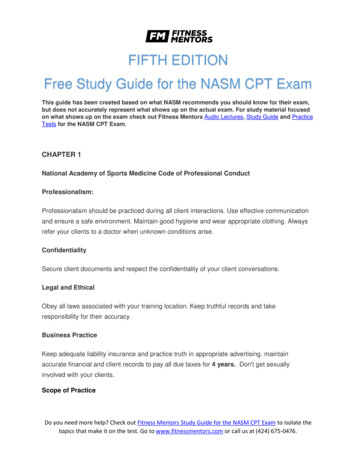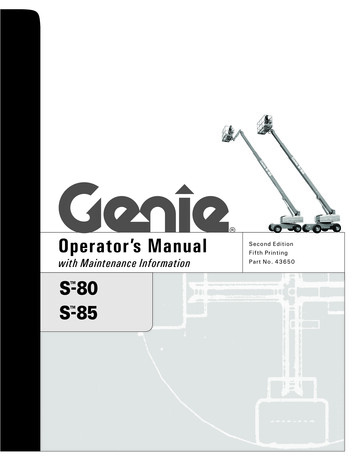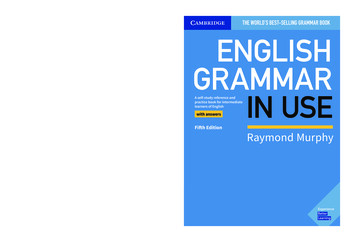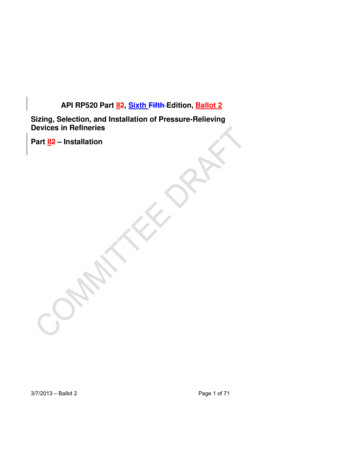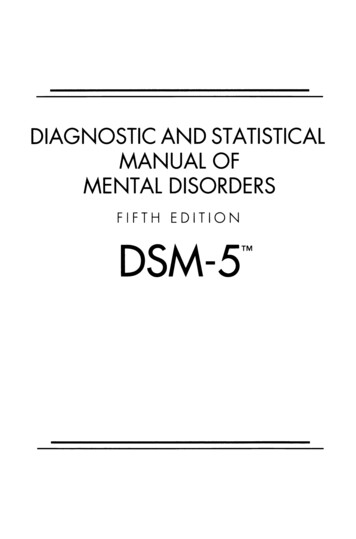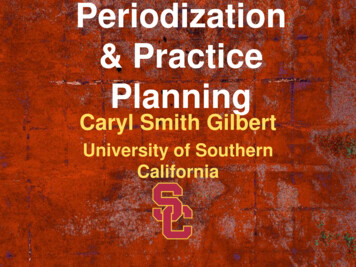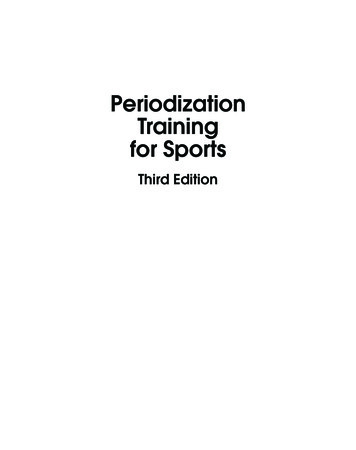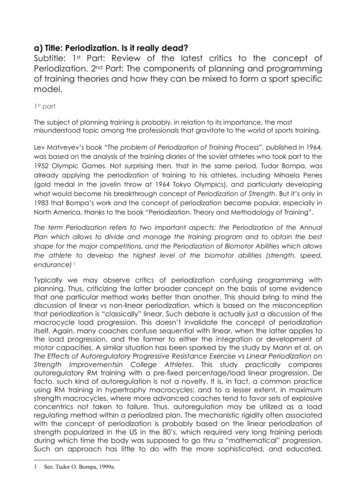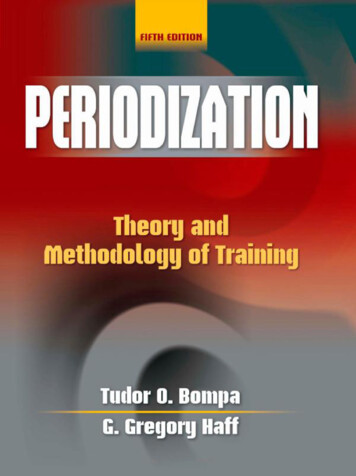
Transcription
Fifth EditionPeriodizationTheory and Methodologyof Training
This page intentionally left blank
Fifth EditionPeriodizationTheory and Methodologyof TrainingTudor O. Bompa, PhDYork UniversityG. Gregory Haff, PhDWest Virginia UniversityNote: This e-book reproduces the text of the printedbook, but it may not include images, tables, or figuresthat have restrictions on electronic distribution.Human Kinetics
Library of Congress Cataloging-in-Publication DataBompa, Tudor O.Periodization: theory and methodology of training / Tudor O. Bompa, G. Gregory Haff.--5th ed.p. cm.Includes bibliographical references and index.ISBN-13: 978-0-7360-7483-4 (hard cover)ISBN-10: 0-7360-7483-X (hard cover)1. Periodization training. 2. Weight training. I. Haff, Greg. II. Title.GV546.B544 2009613.7'11--dc222009017639ISBN-10: 0-7360-7483-X (print)ISBN-13: 978-0-7360-7483-4 (print)ISBN-10: 0-7360-8547-5 (Adobe PDF)ISBN-13: 978-0-7360-8547-2 (Adobe PDF)Copyright 2009 by Tudor O. Bompa and G. Gregory HaffCopyright 1999 by Tudor O. BompaCopyright 1994, 1990, 1983 by Kendall/Hunt Publishing CompanyAll rights reserved. Except for use in a review, the reproduction or utilization of this work in any form or by any electronic, mechanical, or other means, now known or hereafter invented, including xerography, photocopying, and recording, and in any information storage and retrieval system, is forbidden without the written permission of the publisher.Notice: Permission to reproduce the following material is granted to instructors and agencies who have purchasedPeriodization: Theory and methodology of training, Fifth Edition: pp. 344-349. The reproduction of other parts of thisbook is expressly forbidden by the above copyright notice. Persons or agencies who have not purchased Periodization:Theory and methodology of training, Fifth Edition may not reproduce any material.Acquisitions Editor: Michael S. Bahrke, PhD; Developmental Editor: Amanda S. Ewing; Assistant Editors: CarlaZych, Elizabeth Watson, and Casey A. Gentis; Copyeditor: Julie Anderson; Proofreader: Joanna HatzopoulosPortman ; Indexer: Joan K. Griffitts; Permission Manager: Dalene Reeder; Graphic Designer: Joe Buck; GraphicArtist: Dawn Sills; Cover Designer: Bob Reuther; Photo Asset Manager: Laura Fitch; Photo Production Manager:Jason Allen; Art Manager: Kelly Hendren; Associate Art Manager: Alan L. Wilborn; Illustrator: Tammy Page;Printer: Sheridan BooksPrinted in the United States of America10â 9â 8â 7â 6â 5â 4â 3â 2â 1The paper in this book is certified under a sustainable forestry program.Human KineticsWeb site: www.HumanKinetics.comUnited States: Human KineticsP.O. Box 5076Champaign, IL 61825-5076800-747-4457e-mail: humank@hkusa.comAustralia: Human Kinetics57A Price AvenueLower Mitcham, South Australia 506208 8372 0999e-mail: info@hkaustralia.comCanada: Human Kinetics475 Devonshire Road Unit 100Windsor, ON N8Y 2L5800-465-7301 (in Canada only)e-mail: info@hkcanada.comNew Zealand: Human KineticsDivision of Sports Distributors NZ Ltd.P.O. Box 300 226 AlbanyNorth Shore CityAuckland0064 9 448 1207e-mail: info@humankinetics.co.nzEurope: Human Kinetics107 Bradford RoadStanningleyLeeds LS28 6AT, United Kingdom 44 (0) 113 255 5665e-mail: hk@hkeurope.com
ContentsPreface . . . . . . . . . . . . . . . . . . . . . . . . . . . . . . . . . . . . . .Acknowledgments . . . . . . . . . . . . . . . . . . . . . . . . . . . . . . . .Part IixxiTraining Theory1Chapter 1 Basis for Training . . . . . . . . . . . . . . . 3Scope of Training . . . . . . . . . . . . . . . . . . . . . . . . . . . 3Objectives of Training . . . . . . . . . . . . . . . . . . . . . . . . 4Classification of Skills . . . . . . . . . . . . . . . . . . . . . . . . . 6System of Training . . . . . . . . . . . . . . . . . . . . . . . . . . 6Adaptation . . . . . . . . . . . . . . . . . . . . . . . . . . . . . . 8Supercompensation Cycle and Adaptation . . . . . . . . . . . . . 13Sources of Energy . . . . . . . . . . . . . . . . . . . . . . . . . . 21Summary of Major Concepts . . . . . . . . . . . . . . . . . . . . . 30Chapter 2 Principles of Training . . . . . . . . . . . . 31Multilateral Development Versus Specialization . . . . . . . . . .Individualization . . . . . . . . . . . . . . . . . . . . . . . . . . .Development of the Training Model . . . . . . . . . . . . . . . . .Load Progression . . . . . . . . . . . . . . . . . . . . . . . . . . .Sequence of the Training Load . . . . . . . . . . . . . . . . . . . .Summary of Major Concepts . . . . . . . . . . . . . . . . . . . . .313843455355Chapter 3 Preparation for Training . . . . . . . . . . . 57Physical Training . . . . . . . .Exercise for Physical Training .Technical Training . . . . . . .Tactical Training . . . . . . . .Theoretical Training . . . . . .Summary of Major Concepts . .586162667778Chapter 4 Variables of Training . . . . . . . . . . . . . 79Volume . . . . . . . . . . . . . . . . . . . . . . . . . . . . . . . .Intensity . . . . . . . . . . . . . . . . . . . . . . . . . . . . . . .Relationship Between Volume and Intensity . . . . . . . . . . . .Density . . . . . . . . . . . . . . . . . . . . . . . . . . . . . . . .Complexity . . . . . . . . . . . . . . . . . . . . . . . . . . . . . .Index of Overall Demand . . . . . . . . . . . . . . . . . . . . . .Summary of Major Concepts . . . . . . . . . . . . . . . . . . . . .79818693959596v
viâ ContentsChapter 5 Rest and Recovery . . . . . . . . . . . . . . 97Fatigue and Overtraining . . . . . . . . . . . . . . . . . . . . . . 99Recovery Theory . . . . . . . . . . . . . . . . . . . . . . . . . . 104Recovery Interventions and Modalities . . . . . . . . . . . . . . 107Summary of Major Concepts . . . . . . . . . . . . . . . . . . . . 118Part II Periodization of Training123Chapter 6 Annual Training Plan . . . . . . . . . . . . 125Periodization . . . . . . . . . . . . . . . . . . . . . . . . . . . .Periodization of Biomotor Abilities . . . . . . . . . . . . . . . .Periodization of Strength Training . . . . . . . . . . . . . . . .Periodization of Endurance . . . . . . . . . . . . . . . . . . . .Periodization of Speed . . . . . . . . . . . . . . . . . . . . . . .Integrated Periodization . . . . . . . . . . . . . . . . . . . . . .Annual Training Plan Phases and Characteristics . . . . . . . . .Chart of the Annual Training Plan . . . . . . . . . . . . . . . .Criteria for Compiling an Annual Plan . . . . . . . . . . . . . .Summary of Major Concepts . . . . . . . . . . . . . . . . . . . .125137137142143146146160175185Chapter 7 Peaking for Competition . . . . . . . . . . 187Peaking . . . . . . . . . . . . . . . . . .Defining a Taper . . . . . . . . . . . . .Competition Phase of the Annual Plan .Summary of Major Concepts . . . . . . .187188194202Chapter 8 Training Cycles . . . . . . . . . . . . . . . 203Microcycle . . . . . . . . . . . . . . . . . . . . . . . . . . . . . 203Macrocycle . . . . . . . . . . . . . . . . . . . . . . . . . . . . . 229Summary of Major Concepts . . . . . . . . . . . . . . . . . . . . 234Chapter 9 Workout Planning . . . . . . . . . . . . . . 235Importance of Planning . . . . . . . . . . . . . . . . . . . . . .Planning Requirements . . . . . . . . . . . . . . . . . . . . . .Types of Training Plans . . . . . . . . . . . . . . . . . . . . . .Training Session . . . . . . . . . . . . . . . . . . . . . . . . . .Daily Cycle of Training . . . . . . . . . . . . . . . . . . . . . .Modeling the Training Session Plan . . . . . . . . . . . . . . . .Summary of Major Concepts . . . . . . . . . . . . . . . . . . . .235237239240251254256
Contentsâ viiPart III Training Methods257Chapter 10 Strength and Power Development . . . . . 259Biomotor Abilities . . . . . . . . . . . . . . . . . . . . . . . . .Strength . . . . . . . . . . . . . . . . . . . . . . . . . . . . . .Methods of Strength Training . . . . . . . . . . . . . . . . . . .Manipulation of Training Variables . . . . . . . . . . . . . . . .Implementation of a Strength Training Regimen . . . . . . . . .Summary of Major Concepts . . . . . . . . . . . . . . . . . . . .259261269270281284Chapter 11 Endurance Training . . . . . . . . . . . . . 287Classification of Endurance . . . . . . . . . . . . . . . . . . . .Factors Affecting Aerobic Endurance Performance . . . . . . . .Factors Affecting Anaerobic Endurance Performance . . . . . . .Methods for Developing Endurance . . . . . . . . . . . . . . . .Methods for Developing High-Intensity Exercise Endurance . . .Summary of Major Concepts . . . . . . . . . . . . . . . . . . . .287289298300307314Chapter 12 Speed and Agility Training . . . . . . . . . 315Speed Training . . . . . . . . . . . . . . . . . . . . . . . . . . .Agility Training . . . . . . . . . . . . . . . . . . . . . . . . . .Program Design . . . . . . . . . . . . . . . . . . . . . . . . . .Summary of Major Concepts . . . . . . . . . . . . . . . . . . . .315324328342Appendix: Blank Charts for Annual and Four-Year Plans . . . . . . . . . . . .Glossary . . . . . . . . . . . . . . . . . . . . . . . . . . . . . . . . . . . . .References . . . . . . . . . . . . . . . . . . . . . . . . . . . . . . . . . . .Index . . . . . . . . . . . . . . . . . . . . . . . . . . . . . . . . . . . . . .About the Authors . . . . . . . . . . . . . . . . . . . . . . . . . . . . . . .343351357401411
This page intentionally left blank
PrefaceThe classic text Theory and Methodology of Training by Tudor Bompa played a largerole in shaping the training practices of many coaches and athletes throughout theworld. This seminal text eventually became known as Periodization: Theory and Methodology of Training. Since its first publication in 1983 and the fourth edition, whichwas published in 1999, Periodization has presented the latest research and practicesrelated to training theory. The text has been translated into many languages andhas become one of the major resources on periodization for sport scientists, coaches,and athletes throughout the world; in fact, the fourth edition of the text sold morethan 18,000 copies and was translated into six languages. For the fifth edition ofPeriodization: Theory and Methodology of Training, Bompa teams with G. Gregory Haffto couple the classic concepts that are central to periodization and training theorywith contemporary advances in sport science, physiology, and coaching. The fifthedition offers the sport scientist, coach, and athlete information central to understanding the training process while providing scientific support for the principlesfundamental to periodization.Organization of the TextIn the fifth edition, Bompa and Haff organize the text into the three major contentareas found in the fourth edition: Training Theory, Periodization Training, andTraining Methods. Part I, Training Theory, contains five chapters that delve intothe major concepts central to training, such as the concept of bioenergetic specificityof training (chapter 1), the importance of long-term training development (chapter2), the development of basic characteristics associated with training (i.e., tactical,technical, physical) (chapter 3), the variables associated with developing a trainingplan (chapter 4), and the importance of recovery or restoration in the overall trainingprocess (chapter 5). The first five chapters give the coach, sport scientist, and athletethe concepts necessary for understanding and developing periodized training plans,which are addressed in part II.Part II, Periodization of Training, contains four chapters that discuss many ofthe classic concepts found in the fourth edition. These chapters provide expandeddiscussions on the importance of the annual training plan (chapter 6), methods forelevating performance at appropriate times (chapter 7), methods for constructingdifferent training cycles (chapter 8), and how to conceptualize and plan workouts(chapter 9). Chapter 7 couples the current scientific knowledge about the interrelation between training stress and performance with practical information that willallow coaches and athletes to manipulate training to ensure optimal performanceduring competition.The chapters in part III, Training Methods, discuss the
Bompa, Tudor O. Periodization: theory and methodology of training / Tudor O. Bompa, G. Gregory Haff.--5th ed. p. cm. Includes bibliographical references and index. ISBN-13: 978-0-7360-7483-4 (hard cover) ISBN-10: 0-7360-7483-X (hard cover) 1. Periodization training. 2. Weight training. I. Haff, Greg. II. Title. GV546.B544 2009 613.7'11--dc22 2009017639


